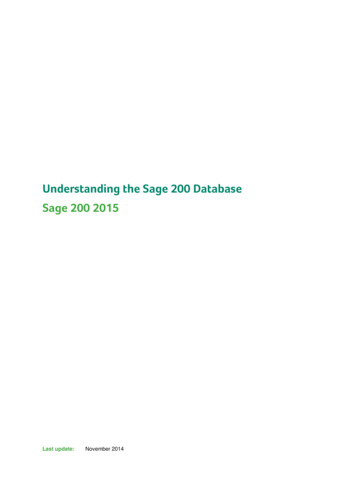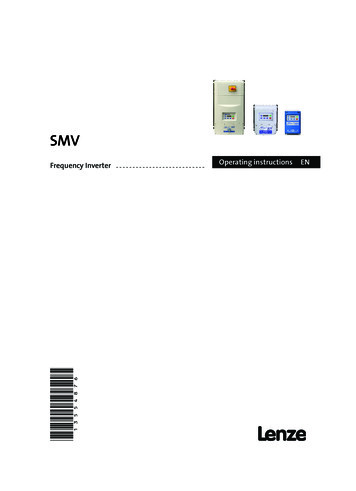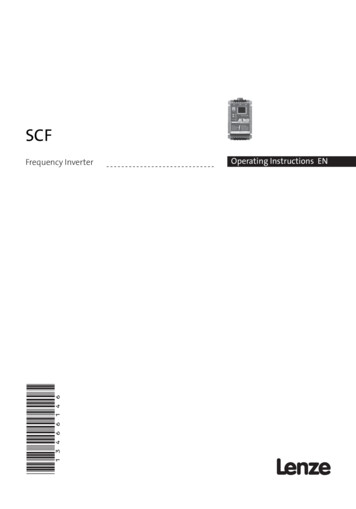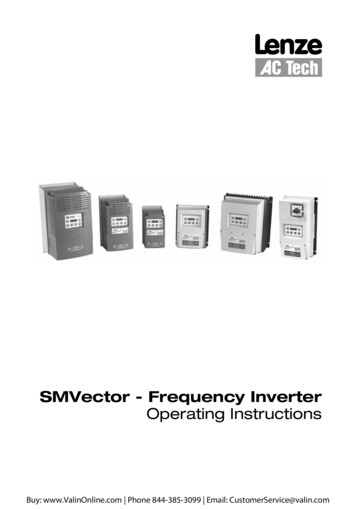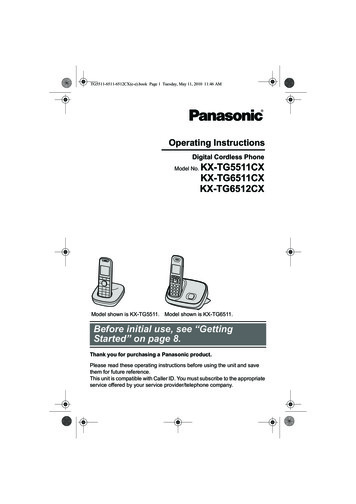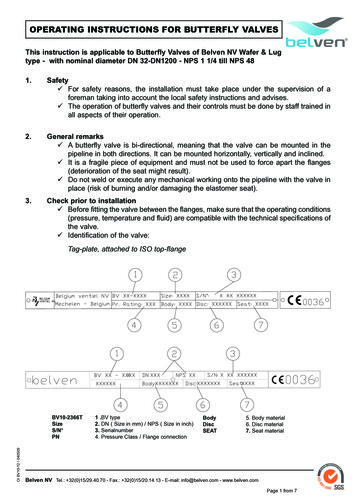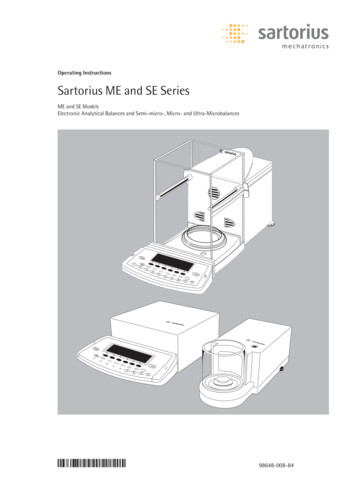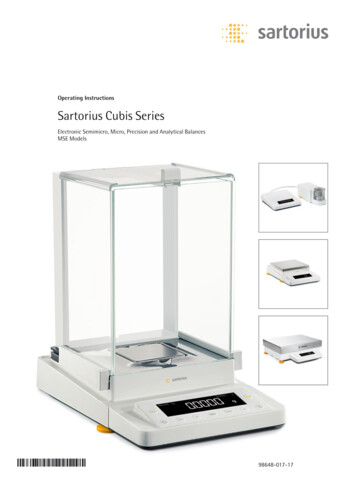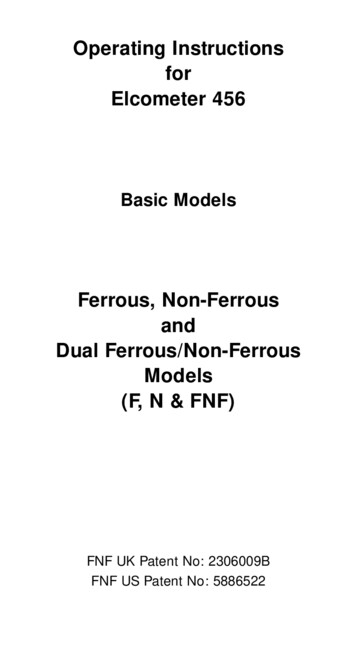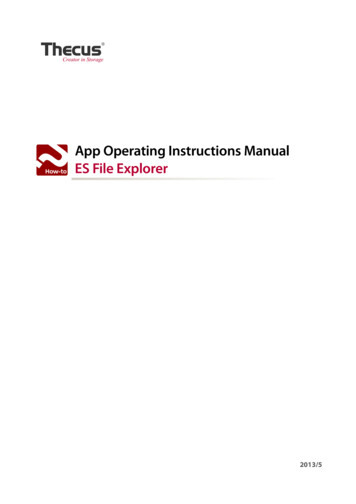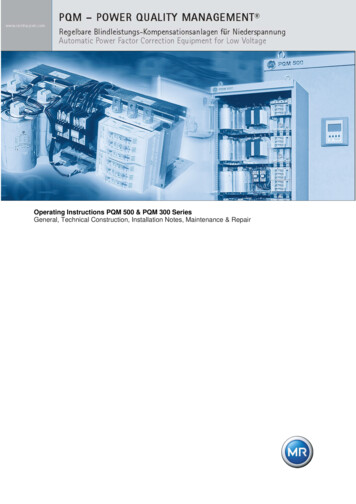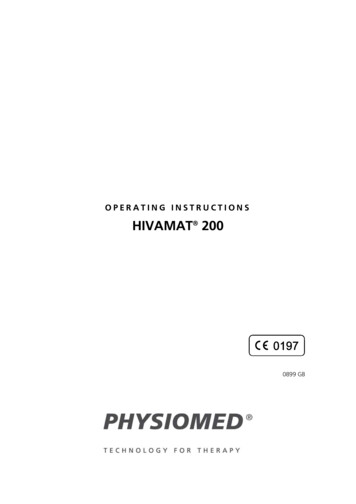
Transcription
OPERATING INSTRUCTIONSHIVAMAT 2000899 GB
Legal NoticeDistribution, reproduction and translation of the software and its documentation (or excerpts thereof) areprohibited without the prior written consent of PHYSIOMED ELEKTROMEDIZIN AG.PHYSIOMED ELEKTROMEDIZIN AG reserves the right to change the software and associated data as wellas the documentation without notice. All other rights reserved.PHYSIOMED ELEKTROMEDIZIN AGHutweide 1091220 SchnaittachGermanyPhone: 49 9126 2587-0Fax: 49 9126 2587-25E-Mail: info@physiomed.deInternet: http://www.physiomed.deHIVAMAT 200 is a registered trademark of PHYSIOMED ELEKTROMEDIZIN AG. The therapy mode hasbeen patented worldwide.HIVAMAT 200 is made in Germany in compliance with the quality requirements of EN ISO13485:2003 AC:2007, EN ISO 9001:2008 and the applicable safety standards and regulations of theCouncil Directive 93/42/EEC of 14 June 1993 concerning medical devices.The compliance with the regulations mentioned here is indicated by the CE label on the instrument. Thedeclaration of conformity might be requested from the manufacturer at the address given above.The compliance with the regulations mentioned here is indicated by the CE label on the instrument.A conformity check acc. to Annex II, approved by the notified body 0197, was carried out.Operating instructions last updated September 15, 2015.
Table of ContentsPHYSIOMED ELEKTROMEDIZIN AGTable of ContentsChapter 1 Introduction . . . . . . . . . . . . . . . . . . . . . . . . . . . . . . . . . . . 11.1Conventions Used . . . . . . . . . . . . . . . . . . . . . . . . . . . . . . . . . 11.2General Notes . . . . . . . . . . . . . . . . . . . . . . . . . . . . . . . . . . . 11.3Instrument Overview . . . . . . . . . . . . . . . . . . . . . . . . . . . . . . . 21.4Instrument Description . . . . . . . . . . . . . . . . . . . . . . . . . . . . . . 21.5Application . . . . . . . . . . . . . . . . . . . . . . . . . . . . . . . . . . . . 31.6Contraindications . . . . . . . . . . . . . . . . . . . . . . . . . . . . . . . . . 3Chapter 2 Controls and Indicators . . . . . . . . . . . . . . . . . . . . . . . . . . . . 42.1Function of Controls and Indicators . . . . . . . . . . . . . . . . . . . . . . . . 42.1.1Mains Module 1 . . . . . . . . . . . . . . . . . . . . . . . . . . . . . . . . 42.1.2Massage Key 2 . . . . . . . . . . . . . . . . . . . . . . . . . . . . . . . . . 42.1.3Frequency Selector 3 . . . . . . . . . . . . . . . . . . . . . . . . . . . . . . 52.1.4Mode Selector 4 . . . . . . . . . . . . . . . . . . . . . . . . . . . . . . . . 52.1.5Timer 5 . . . . . . . . . . . . . . . . . . . . . . . . . . . . . . . . . . . . . 52.1.6Intensity Control 6 . . . . . . . . . . . . . . . . . . . . . . . . . . . . . . . 62.1.7Intensity Display 7 . . . . . . . . . . . . . . . . . . . . . . . . . . . . . . . 62.1.8Turn-Down Indicator 8 . . . . . . . . . . . . . . . . . . . . . . . . . . . . . 62.1.9Connector Sockets 9 . . . . . . . . . . . . . . . . . . . . . . . . . . . . . . 62.1.10Patient Indicator 10 . . . . . . . . . . . . . . . . . . . . . . . . . . . . . . . 72.1.11Charge Display 11 . . . . . . . . . . . . . . . . . . . . . . . . . . . . . . . 7Chapter 3 Instrument Operation . . . . . . . . . . . . . . . . . . . . . . . . . . . . . 8HIVAMAT 2003.1Operation in Mains Mode or Battery Mode . . . . . . . . . . . . . . . . . . . . 83.1.1Notes on Handling the Batteries. . . . . . . . . . . . . . . . . . . . . . . . . . 93.2Preparations and Start-Up . . . . . . . . . . . . . . . . . . . . . . . . . . . . . 93.2.1Mains Operation. . . . . . . . . . . . . . . . . . . . . . . . . . . . . . . . . . 93.2.2Battery Operation . . . . . . . . . . . . . . . . . . . . . . . . . . . . . . . . 103.3Function Check . . . . . . . . . . . . . . . . . . . . . . . . . . . . . . . . . 103.4Cable Check . . . . . . . . . . . . . . . . . . . . . . . . . . . . . . . . . . . 103.5Hand Applicator . . . . . . . . . . . . . . . . . . . . . . . . . . . . . . . . . 113.6Instrument Errors . . . . . . . . . . . . . . . . . . . . . . . . . . . . . . . . 12i
PHYSIOMED ELEKTROMEDIZIN AGTable of ContentsChapter 4 Treatment . . . . . . . . . . . . . . . . . . . . . . . . . . . . . . . . . . . 134.1Preparations and Attachment . . . . . . . . . . . . . . . . . . . . . . . . . . 134.2Massage Frequency . . . . . . . . . . . . . . . . . . . . . . . . . . . . . . . 144.3Massage Duration . . . . . . . . . . . . . . . . . . . . . . . . . . . . . . . . 144.4Instrument Modes . . . . . . . . . . . . . . . . . . . . . . . . . . . . . . . . 144.5Massage Intensity . . . . . . . . . . . . . . . . . . . . . . . . . . . . . . . . 154.6Massage Technique . . . . . . . . . . . . . . . . . . . . . . . . . . . . . . . 15Appendix A Appendix . . . . . . . . . . . . . . . . . . . . . . . . . . . . . . . . . . . 16A.1Customer Service, Maintenance, Service . . . . . . . . . . . . . . . . . . . . 16A.2Cleaning and Disinfection . . . . . . . . . . . . . . . . . . . . . . . . . . . . 16A.3Service Life and Disposal. . . . . . . . . . . . . . . . . . . . . . . . . . . . . 16A.4Electromagnetic Compatibility. . . . . . . . . . . . . . . . . . . . . . . . . . 17A.5Training . . . . . . . . . . . . . . . . . . . . . . . . . . . . . . . . . . . . . 17A.6Technical Data . . . . . . . . . . . . . . . . . . . . . . . . . . . . . . . . . . 17A.6.1Environment Conditions . . . . . . . . . . . . . . . . . . . . . . . . . . . . . 18Appendix B Scope of Delivery and Accessories . . . . . . . . . . . . . . . . . . . . 19B.1Standard Accessories . . . . . . . . . . . . . . . . . . . . . . . . . . . . . . 19B.2Additional Accessories. . . . . . . . . . . . . . . . . . . . . . . . . . . . . . 19Appendix C Supplementary Documents . . . . . . . . . . . . . . . . . . . . . . . . 21C.1Manufacturer's Recommendations . . . . . . . . . . . . . . . . . . . . . . . 21Index . . . . . . . . . . . . . . . . . . . . . . . . . . . . . . . . . . . . . . 22iiHIVAMAT 200
1 IntroductionPHYSIOMED ELEKTROMEDIZIN AGChapter 1 IntroductionWith HIVAMAT 200 you have acquired an extremely versatile massage-intensifying system. The instrument will only show its true potential, however, if you are well informed about its functions. For this reason, carefully read these Operating Instructions and familiarise yourself with the use of the instrument.1.1 Conventions UsedPlease note the following typographical conventions in these Operating Instructions: Cross references and important terms used for the first time in this document are written in italics.Names of menus and symbols on the display are written in bold typeface.Paragraphs that deserve special attention are highlighted in the following way:SymbolTypeMeaningTipGives you some extra hints for more convenient operationNoteProvides background information for better understandingImportantPrevents misunderstandings that might lead to limited operation of the instrument or insufficient therapeutical resultsCautionAlerts you in cases of possible damage to the instrument or risks of injury1.2 General NotesHIVAMAT 200 is consistent with electrical safety regulations for home and most clinical environments.The instrument may only be operated in dry rooms. It complies with the technical specifications of IEC601, VDE 0750 and is assigned to class IIa according to the Council Directive 93/42/EEC concerning Medical Devices.It is not intended for operation in explosion hazard zones, hydrotherapy rooms or surgery rooms. Drastictemperature changes should be avoided, since condensation could be caused within the instrument. Donot start up the instrument until it is in thermal equilibrium with its environment!Please refer to section Technical Data on page 17 for permissible operating conditions.The equipment is not suitable for use in the presence of flammable anaesthetic gases mixed with air orwith oxygen or nitrous oxide. During operation, electromagnetic waves are emitted by the instrument.Please consider this exposure in its environment and care for sufficient distance from other electronicdevices. Please also take into account that the electromagnetic waves of other devices might interfere withthe instrument and take care that these devices have sufficient distance from the instrument.The instrument is to be operated properly, i.e. in accordance with the Operating Instructions. Operatingthe instrument in the proximity (e.g. 1 m) of a short-wave or micro-wave therapy unit may cause output irregularities and should be avoided for this reason, as well as simultaneous connection of the patient tohigh-frequency surgical instrument.HIVAMAT 2001
1 IntroductionPHYSIOMED ELEKTROMEDIZIN AG1.3 Instrument OverviewFront PanelRear FaceLegend1Mains Module2Massage Key3Frequency Selector4Mode Selector5Timer6Intensity Control7Intensity Display8Turn-Down Signal9Connector Sockets10Patient Indicator11Charge Display1.4 Instrument DescriptionHIVAMAT 200 is a massage-intensifying system which is successfully used in various areas of medicine.All functions of HIVAMAT 200 are controlled by a microprocessor, which also continuously monitors important components and suppresses erroneously initiated operating steps. After switching on the unit, allinstrument functions are automatically checked during a self-test routine.The intention of treatment with HIVAMAT 200 is not to replace existing therapeutic methods. On thecontrary, it is aimed at supporting, intensifying and thus improving the effects and lastingness of manualmassage techniques, such as classic massage, anti-edema therapy, vibration-intensified massage, massagein sports and manual lymphatic drainage. Due to its enormous depth effect with minimal mechanical action, the application of the HIVAMAT 200 opens up the possibility of treating indications that, so far,were considered to be not treatable by means of physical therapy. Therapy with HIVAMAT 200 can beperformed by the therapist or by the patients themselves.2HIVAMAT 200
1 IntroductionPHYSIOMED ELEKTROMEDIZIN AGWe recommend that HIVAMAT 200, no matter if with or without the applicator, is only applied by qualified physiotherapists or under direction of those.CAUTIONRefrain from HIVAMAT 200 treatment if the therapist or patient carry cardiac pacemakers orother implanted stimulators. Equally, therapy must not be per-formed on patients or by therapists who are particularly sensitive to electric fields, in case of heart complaints or pregnancy.Attend to the contraindications to HIVAMAT 200 therapy (refer to Contraindications onpage 3)!When using HIVAMAT 200, switch off or plug off electrocardiographs and other diagnosticdevices for recording endogenous signals.1.5 ApplicationThe function of HIVAMAT 200 is based on a pulsed electrostatic field which is built up in the patient'sbody region to be treated. Its frequency changes between 5 - 250 Hz, according to the selected indication.Due to the movement of the applicator, a vibrating or pumping effect with deep impact is induced in thepatient's tissue.Treatment with HIVAMAT 200 has the following positive effects on the treated tissue: trophic enhancementmuscle relaxationpain reductionedema reductioninhibition of inflammationsenhancement of wound healing1.6 ContraindicationsTherapy with HIVAMAT 200 is not indicated in the following cases: HIVAMAT 200acute inflammations with participation of pathogenic agentsinfectious skin diseasesacute venous diseases (varicophlebitis, thrombophlebitis, deep venous thromboses)malignant processespatients and therapists with cardiac pacemakers and other electronic implantsheart disorders and diseases, especially cardiac insufficiency, decompensated cardiac edemacardiac arrhythmiahypersensitivity to electrostatic fieldspregnancy3
2 Controls and IndicatorsPHYSIOMED ELEKTROMEDIZIN AGChapter 2 Controls and IndicatorsThe design of HIVAMAT 200 allows for easy operation, in combination with a variety of functions. Due toits compact size, the instrument is very easy to transport. It has been designed for operation also outsideof therapy rooms, and can be fed by rechargeable batteries for that reason.All controls and indicators are integrated into the housing, thus allowing for easy cleaning of the instrument's surface and protecting it from dust.The instrument's microprocessor monitors the safety-related components, prevents from erroneous operation and checks the instrument after switching it on.2.1 Function of Controls and IndicatorsThe following section introduces the individual indicators and controls of HIVAMAT 200. The numbers inangle brackets refer to the Instrument Overview on page 2.2.1.1 Mains Module 1 The mains module 1 with mains supply, fuses and mains switch issituated at the rear side of the instrument. The mains module 1 allows for mains voltages from 110 to 240 VAC. HIVAMAT 200 isswitched on and off using the integrated mains switch. After switching on, the instrument is in stand-by mode.CAUTIONAlways ensure that the mains voltage matches 110 . 240 VAC, 50 . 60 Hz (refer to Technical Data on page 17).2.1.2 Massage Key 2 The massage key 2 turns on the power supply for the instrumentwhen it is in stand-by mode. As soon as the massage key 2 hasbeen pressed, an automatic self-test routine is performed by the instrument (refer to Function Check on page 10). After that, the instrument is ready for use.4HIVAMAT 200
2 Controls and IndicatorsPHYSIOMED ELEKTROMEDIZIN AG2.1.3 Frequency Selector 3 The display of the frequency selector 3 shows the massage frequency selected in Hz. Using the plus and minus keys, the massagefrequency may be continuously selected within the range of 5 - 200Hz. The frequency can be turned high or down in 1 Hz steps or, bypro-longed pressing, in larger steps (repeat function). The default setting after switch-on is 100 Hz.2.1.4 Mode Selector 4 The display of the mode selector 4 shows the individual ratio ofpulse time t
HIVAMAT 200 is a massage-intensifying system which is successfully used in various areas of medicine. All functions of HIVAMAT 200 are controlled by a microprocessor, which also continuously monitors im-portant components and suppresses erroneously initiated operating steps. After switching on

